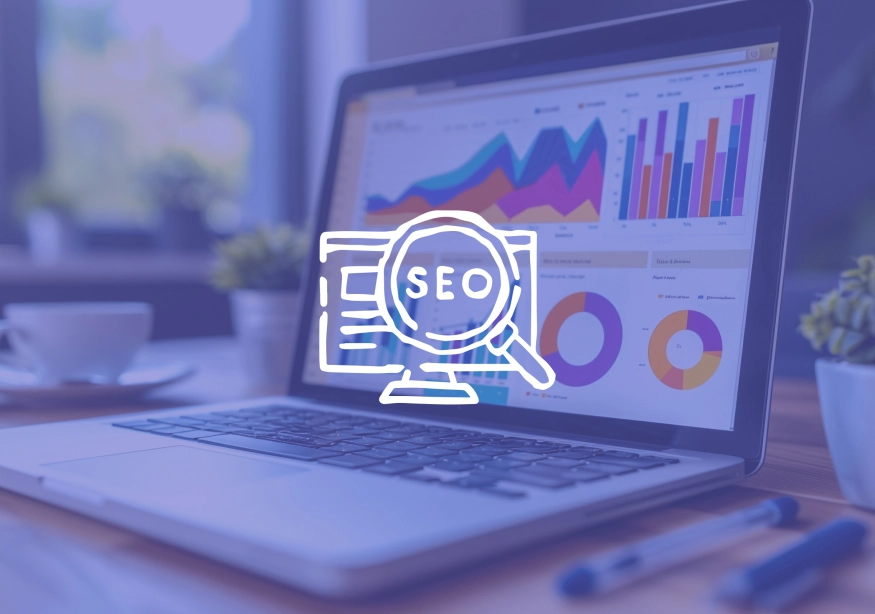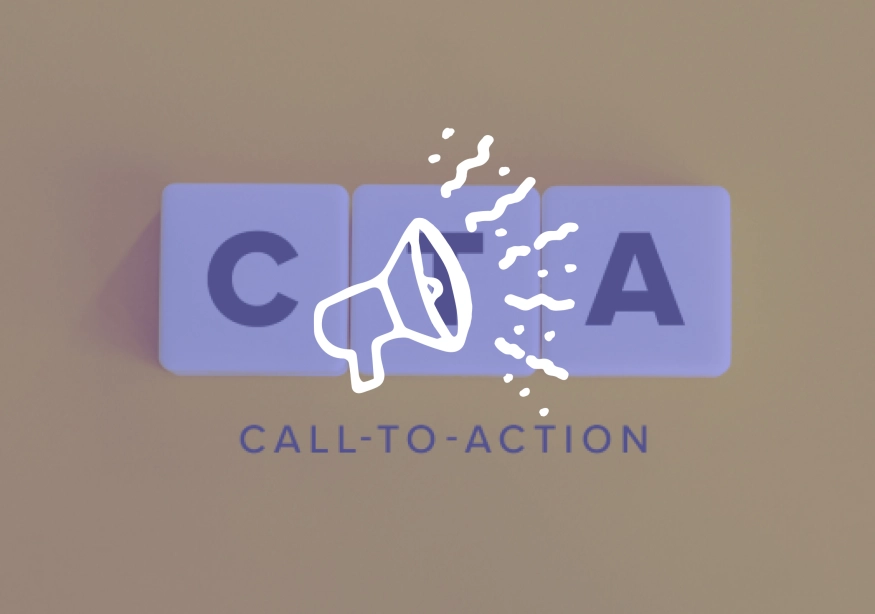With many potential clients turning to the internet for information, a well-designed website is crucial to attract and retain customers. That’s why we’re going to share some best practices for B2B web design, focusing on the unique needs of your business and the goals you aim to achieve.
Understanding B2B Web Design
B2B web design goes beyond aesthetics; it involves creating a user-centric experience that facilitates business transactions and fosters relationships. Unlike B2C websites, which may prioritize emotional appeal and quick purchases, B2B websites often house more complex sales processes that require clear information and functionality.
Effective B2B sites must also support brand loyalty and trust to streamline lead generation and nurturing processes. Elements such as intuitive navigation, detailed product descriptions, and easy access to customer support play vital roles in ensuring that potential clients can find what they need without frustration. Additionally, incorporating case studies and testimonials can significantly enhance credibility, as they provide proof of your company’s reliability and success in solving similar challenges faced by other businesses.
Importance of B2B Web Design
A well-structured website serves as a powerful marketing tool, promoting products and services while showcasing the brand's credibility. Strong web design can lead to increased traffic, higher conversion rates, and more substantial customer relationships. In the B2B landscape, where decisions are often made by multiple stakeholders, a professional and informative website can serve as a pivotal resource in the decision-making process.
When a website is designed with B2B principles in mind, it provides a seamless experience for users, making it easier for them to find relevant information and complete transactions. This, in turn, supports lead generation and ultimately increases revenue for the business. Integrating other useful features such as live chat support, comprehensive FAQs, and resource libraries can enhance the user experience, ensuring that potential clients feel supported throughout their journey. By prioritizing functionality alongside design, businesses can create a platform that attracts visitors and converts them into loyal customers, fostering long-term partnerships essential for sustained growth in the competitive B2B market.
Key Elements of B2B Web Design
So, how do you craft an effective B2B website? There are a few factors you need to consider, and most of these components revolve around the usability of the interface.
User Experience (UX)
User experience (UX) plays a huge role in the effectiveness of a B2B website. Designers must create intuitive layouts that guide users through information efficiently. Visitors need to be able to quickly locate what they're looking for, whether it’s product details, pricing, or support. The longer it takes the user to get where they need to be, the more likely they are to bounce completely and search for another solution.
Did you know that 94% of online users say that easy navigation is the most important website feature?
To enhance UX, B2B sites should employ clear navigational structures, consistent design elements, and responsiveness to different devices. User testing should also be a driver that can help you make ongoing improvements. The goal is to create a seamless journey that not only meets user expectations but exceeds them, fostering loyalty and repeat visits.
Visual Aesthetics and Branding
The visual design of a B2B website should reflect the company's brand identity while appealing to its target audience. This includes using a relevant color palette, typography, and graphics that resonate within the industry. A strong brand presence enhances recognition and fosters trust.
Moreover, infographics and professional imagery can help communicate complex information in an easily digestible manner, improving user engagement as a result. Consistent branding across all pages is crucial for maintaining a professional appearance and reinforcing brand credibility. Incorporating video content can be another way to showcase products or services, as it allows potential clients to visualize their benefits in action. This dynamic approach not only captivates users but also encourages them to share content, broadening the brand's reach and influence within the industry.
Mobile Optimization
With an increasing number of users accessing websites via mobile devices, mobile optimization has become a non-negotiable element of B2B web design. A mobile-responsive design makes sure that your website functions well across various devices and screen sizes, delivering a consistent experience regardless of how users access your site.
Best B2B Website Examples
We continue to talk about key aspects of B2B web design, but the proof is in the pudding. Here are some of our top picks that stick out to us when we think about web design best practices.
Hubspot
While this one may seem obvious, we couldn’t leave out one of the leading CRM platforms that has nailed its web design approach. HubSpot not only includes two clear paths for the user to take, but it also features strong social proof right above the fold that validates their authority in the CRM industry. Including logos of customers you’ve worked with is a quick and easy way to boost your reputation and positively influence the user’s decision-making.
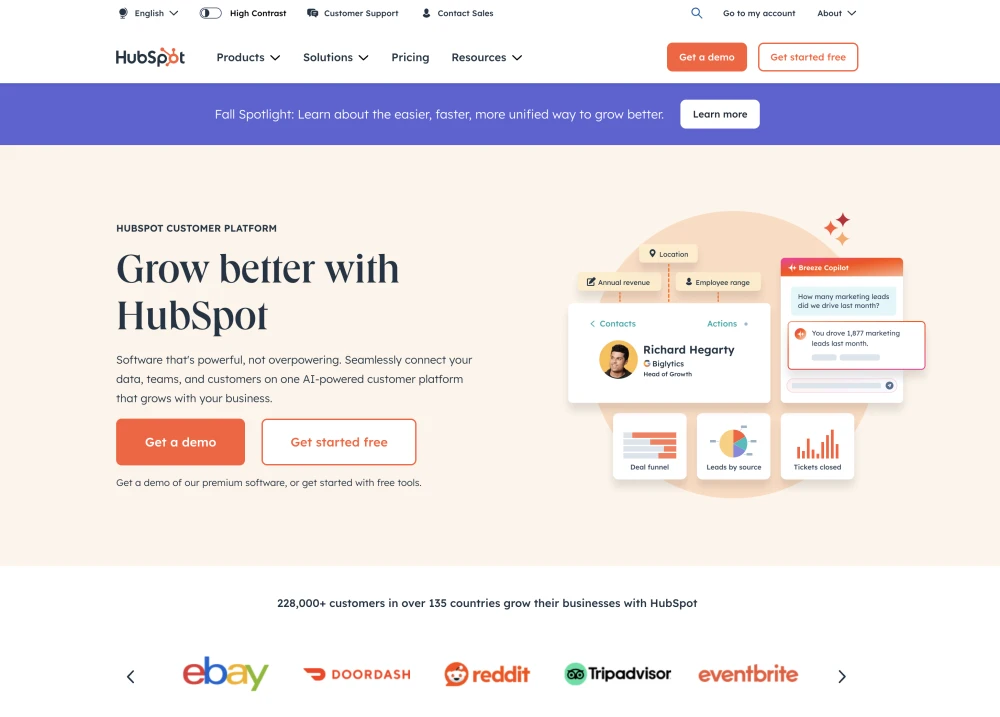
Miro
The best way to approach your B2B web design is by showing instead of telling. Miro does a great job of providing simple screen recordings of their platform so that you can visualize what it will look like to utilize their platform. Without these visuals, it would be tough to envision implementing their tool into your business just by reading what it could do for you.
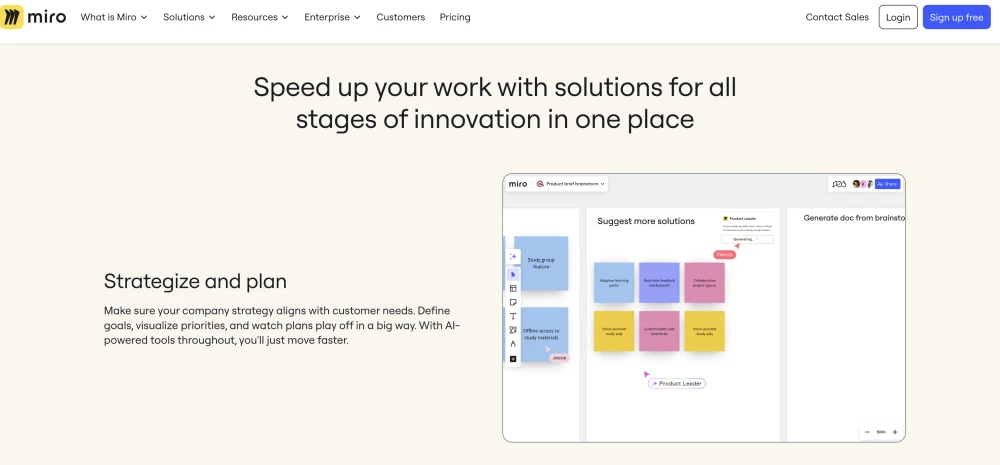
ClickUp
If your B2B product/service includes a lot of different features or solutions, your top navigation bar needs to be organized well enough for the visitor to access what they particularly need within your different offerings. ClickUp does this well even though they have a lot of different products and services. The worst thing you can do is bury key information that will negatively impact your conversion rate. As you can see in the screenshot below, ClickUp’s products are clearly organized under different categories based on the capabilities of each feature:

MailerLite
With B2B websites, you want to keep the visitor scrolling, so your front homepage should feature a snippet above the fold that gives a preview of what’s next if the user explores further down the page. MailerLite does this with a clean, interactive graphic that entices the user to scroll to see more of what it’s explaining. Another fun aspect of their homepage is that the heading is short and to the point, but they change the copy “email marketing” highlighted in green to switch between all of their service offerings.

Web Design Best Practices
Based on the few examples we’ve given, it’s clear that there are certain best practices you should implement when it comes to your B2B web strategy. Keep these tips in mind and don’t forget to add your own flair to your website that gives your business a distinct character!
Creating Clear and Concise Content
Content is king in any web design, but particularly in B2B spaces, where your audience seeks helpful information and transparency. Crafting clear and concise content that addresses your target audience's pain points will position your business as a thought leader.
Utilizing a structured format that includes headings, bullet points, and relevant images can make your content easily scannable. Diversify your content to include helpful resources, such as white papers and case studies, which can serve as lead magnets. Or consider incorporating interactive elements like infographics and videos to further engage your audience.
Prioritizing Navigation and Usability
A well-organized navigation structure is fundamental to the usability of your website. Users should effortlessly find information without feeling overwhelmed or frustrated. Logical categorization of services, along with prominent search functionality, can significantly enhance the usability of a B2B site.
Use clear call-to-actions (CTAs) throughout the website to guide users toward your main goal, such as signing up for a newsletter or requesting a demo.
Incorporating Social Proof
To foster trust with potential customers, it’s essential to showcase social proof on your website. This can include testimonials, client logos, case studies, and industry awards. Social proof validates your claims and helps potential clients feel more confident in their decision to engage with your company.
Incorporating quantitative results from previous clients makes you look less like a newbie and more like an expert. This may include statistics about improved efficiency or cost savings, which can be particularly persuasive for B2B decisions. Consider featuring video testimonials or interviews with satisfied clients, as these can create a more personal connection and enhance the authenticity of your social proof.
Focusing on SEO
Search Engine Optimization (SEO) is critical in B2B web design to improve visibility and attract organic traffic. Implementing effective SEO strategies involves researching relevant keywords, optimizing metadata, and ensuring your site has a fast loading speed.
Regularly updating content and maintaining a blog can also contribute to your overall SEO performance. Quality backlinks and strategic partnerships can enhance authority, further boosting your search rankings.
Mistakes to Avoid in Web Design
With best practices, come some mistakes that you have to keep in mind that you want to avoid as much as possible.
Overloading Information
While it is essential to provide valuable content, overwhelming users with excessive information can lead to decision fatigue. It can also dilute the core message you want your website to convey.
Your visitors are never going to read long paragraphs. Avoid lengthy pieces of content, as these can deter users from staying on your page. Consider using bullet points, infographics, and concise summaries to break down complex information. This approach not only enhances readability but also allows users to quickly grasp the essential points, making their browsing experience more enjoyable and productive.
Ignoring SEO
Failing to implement SEO practices during web design can greatly limit your website's reach. Without strategic SEO, your site may struggle to rank well on search engines, resulting in lost opportunities and traffic.
Incorporating SEO best practices throughout the web design process ensures your website remains discoverable and relevant to potential clients searching for your products or services. This includes optimizing meta tags, using descriptive alt text for images, and ensuring fast loading times. Moreover, creating high-quality, keyword-rich content that addresses the needs and questions of your target audience can significantly boost your site's visibility. Regularly updating your content and monitoring SEO performance can also keep your website competitive in an ever-evolving digital landscape.
Measuring the Success of Your B2B Web Design
For B2B web design, you won’t know where improvements need to be made unless you pay close attention to analytics that track your performance. Here are a few ways to effectively monitor your strategy and find areas to tweak it when necessary.
Key Performance Indicators (KPIs) for B2B Web Design
To gauge the effectiveness of your B2B web design, establish key performance indicators (KPIs) that align with your business goals. Common KPIs to monitor include website traffic, bounce rates, conversion rates, and session duration.
By tracking these metrics, businesses can identify what elements of their design are working well and where improvements are needed. Regular assessment allows for iterative improvements, aligning with ever-evolving user expectations. It’s also crucial to consider user feedback as a qualitative measure of success. Conducting surveys or interviews with users can provide insights into their experiences and help pinpoint specific areas for enhancement. This combination of quantitative data and qualitative feedback creates a comprehensive picture of your website's performance.
Tools for Tracking Web Design Success
Utilizing analytics tools is essential for tracking the success of your B2B web design. Google Analytics, for example, provides insights into user behavior, traffic sources, and website performance. Other specialized tools like Hotjar offer heatmaps that reveal where users click and scroll, providing valuable insights into UX:
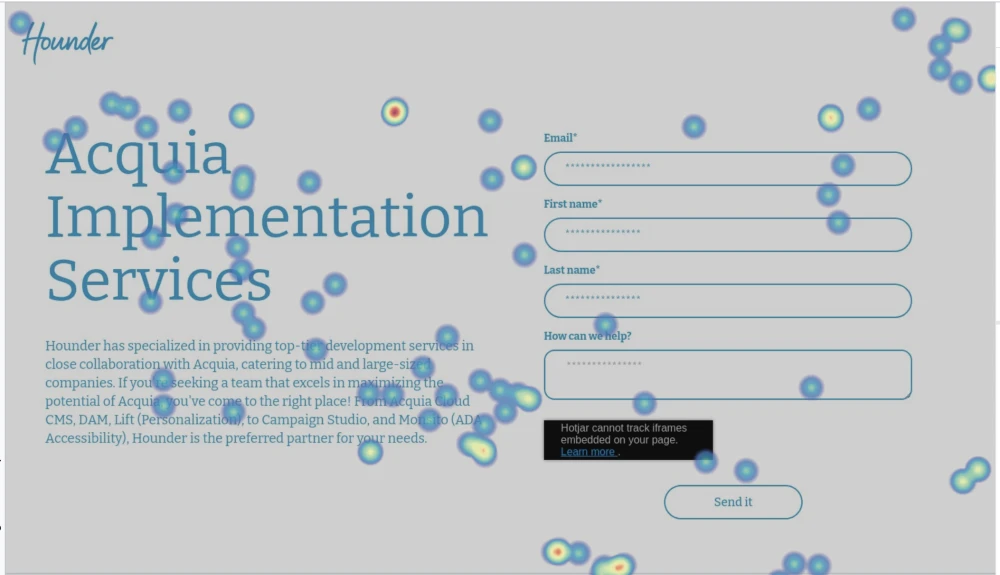
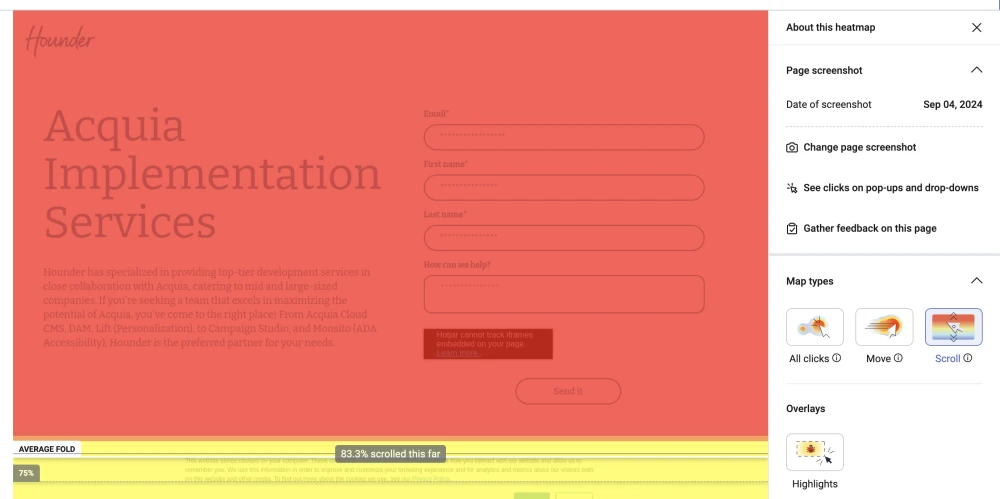
By leveraging these tools, businesses can make informed decisions to improve engagement and conversion rates based on data-driven insights. Go the extra mile by A/B testing with different design elements, allowing you to see which variations resonate best with your audience. This iterative process not only enhances user experience but also fosters a culture of continuous improvement within your organization, ensuring that your web design remains relevant and effective in meeting the needs of your target market.
How a B2B Web Design Agency Can Help
If you’re struggling to optimize your B2B web design strategy on your own, an external expert could be the solution. While we may be biased, Hounder is a B2B web design agency that specializes in developing strong digital transformation projects. Check out our case studies to see the success we’ve achieved while working with a variety of B2B businesses.
Need to revisit your B2B web design strategy but don’t know where to start?
We can help! Schedule a call with us and we can chat about the right approach you should take to reach your business goals.

